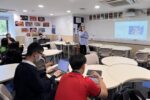CISxHackathon Competition Updates
We are team “Hackneyed Hackers🤯” and we joined the CISxHackathon Competition!
It was great fun. The process of working as a team and submitting our work was really fulfilling. We all unanimously agree that the teamwork and academic experience of participating in this hackathon was great and will prove useful for the future. This was our first competition that involved a lot of coding with creativity, so it helped us improve and learn new skills. We were pleased with how we went, and hope to do even better next time and in future competitions.
If you are interested to view our competition entry, it can be found here.
The mission we took on was to help solve the problem of poor rates of recycling in Hong Kong. During the Covid-19 pandemic, the quantity of rubbish not being recycled has dramatically increased. The amount of single-use plastic used for takeaways over the past few months has increased by 2.2 times compared to the same period last year. Meanwhile, in near December of 2019, according to the most recent figures released by the Environmental Protection Department (EPD), the rubbish recycle rate per person in Hong Kong was already at the worst levels since records began in 1991. The bigger problem is that a lot of people don’t bother to recycle rubbish properly! As more recycling bins are available, the rubbish disposal rate per person in Hong Kong is dropping.
In April 2020, Green Sense undertook an online survey regarding shopping packaging. Over 40% of the respondents indicated that they were unclear about the categories of different recyclables and 20% of the respondents confessed that they were unfamiliar with information on where to deposit the recyclables. According to research, people are not clear about the categories of different recyclable rubbish. To solve this grave problem, we came up with a solution – a smart rubbish bin capable of performing object recognition (Using Python, Opencv and Yolov3) and sorting rubbish into different categories.
To design our product, we first used CAD (Computer Aided Design) to model the solution, then, using foam board, motors, a raspberry pi (a processing unit) and a camera. We later assembled a working prototype of our solution as part of our submission. A direct link to the video demonstration is here.
By Isaac Leung (10D1), Gordon Zhang (10D2), Hailey Lau (10D2) and Vincent Wang (10P2)

